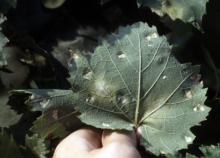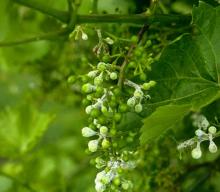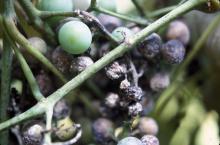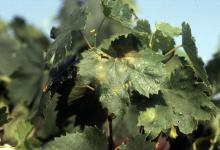See:
Boston Ivy (Parthenocissus tricuspidata) - Downy Mildew
Cause The fungus-like organism Plasmopara viticola has not been reported from grape in the Pacific Northwest, but the disease has been reported from at least seven California counties. One OSU Plant Clinic specimen from a home garden was diagnosed with downy mildew in 1966. Several clades (like forma species) of the fungus have been identified with P.v. clade aestivalis encountered the most in Eastern North America. The clade (also called Plasmopara muralis) found on Boston ivy or Virginia creeper does not infect grape and vice versa. The organism was detected on Boston ivy plants in Oregon in 2001. One landscape planting of Boston ivy without overhead irrigation had symptoms of the disease. This may indicate that western Oregon can sustain natural spread and expression of this disease.
Spring weather west of the Cascade Range would be highly conducive to disease development if the pathogen ever is introduced into grape vineyards. It can be spread by transporting infected vines or nursery stock or within plant debris or soil that contains oospores of the organism. The organism can overwinter or be transmitted as mycelium in dormant buds.
Symptoms Lesions can be on any green part of the vine. Lesions are yellowish and oily or angular, yellow to reddish brown, and limited by veins. In moist weather, a delicate dense, white growth is on the leaf underside opposite lesions seen on the upper side. Severely infected leaves drop, and vines may show premature defoliation. Shoot tips can die back; immature berries are highly susceptible. Symptoms may be easily confused with the grape erineum mite damage, which produces a puckered area with numerous white trichomes (that later turns darker) on the undersides of leaves.
Cultural control Quarantine and scouting are the best ways to keep it out of vineyards.
- Do not transport infected stock into the region. Do not bring infected plant debris or soil into the region.
- Scout vineyards for any sign of the disease. Check newly planted stock originating out of state. If it is suspected, get diseased plant samples to a public diagnostic laboratory as soon as possible to confirm the diagnosis.
- Avoid overhead irrigation or practices that maintain wet foliage for extended periods of time.
Chemical control The Pacific Northwest does not have the disease in grapevines, so there is no need for chemical control applications.
References Rouxel, M., Mestre, P., Baudoin, A., Carisse, O., Delière, L., Ellis, M.A., Gadoury, D., Lu, J., Nita, M., Richard-Cervera, S., and Schilder, A. 2014. Geographic distribution of cryptic species of Plasmopara viticola causing downy mildew on wild and cultivated grape in eastern North America. Phytopathology 104:692-701.
Wilcox, W.F., Gubler, W.D., and Uyemoto, J.K. 2015. Compendium of grape diseases, disorders, and pests. Second edition. St. Paul, MN: APS Press.





